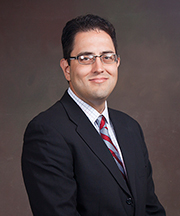- Anesthesiologist specializing in non-surgical spine care
Fellowship-trained in Interventional Spine
Nonsurgical pain relief
Return to activity | Diagnostics | Pain relief | Time | Limiting rest | Physical therapy | Exercise | Injection therapy | Types of medication | Massage | Biofeedback | Acupuncture
For damaged structures to heal, good blood supply is essential for repair and to remove waste products. The bones, ligaments and muscles in the back have a good blood supply, so the back can heal reasonably well. The problem is that they usually heal with a special type of tissue called scar tissue, which is strong but not as flexible as normal muscles, ligaments, etc. However, discs have a poor blood supply and this often results in slower healing. Discs, therefore may be more easily damaged if care is not taken to prevent this. The most common type of injury to the back is to the soft tissue – the muscles, tendons and ligaments. Most of these soft tissue injuries heal well, and this is why most people with back injuries recover.
Back pain is often an unseen injury to others. As such, it is sometimes difficult to understand the problems that a person with back injury has to live with daily. To help yourself, it is important to keep as mobile as possible and learn how to move your body to prevent strain on your back.
Return to activity
The primary goal of treatment is to get you back to your everyday activities.
During your initial visit, the physician will assess
your medical history and collect more specific information during the
exam. In order to better understand your back or neck problem, the
physician may gently move your joints and limbs. It is important to
answer all the physician’s questions honestly, because your answers
help determine a correct diagnosis.
[Top]
Types of diagnostics you may encounter:
- X-rays show bones and the space between bones. Although X-rays are of limited value to muscle-related back pain cases, your physician may conduct X-rays to detect possible fractured vertebrae or narrowing of disc space.
- MRIs (Magnetic Resonance Imaging) and CT scans provide images of soft tissues and nerves in the spine, including discs and joints. This is valuable information to your physician in determining the cause of your pain. These tests provide a medical photograph of your body and are painless.
- Pain-relieving injections can relieve back pain and provide important information about your problem.
- Myelograms can reveal the amount of damage in the spine. They are used to determine if surgery is necessary. If it is, myelograms provide a surgeon with key information to ensure the success of surgery.
Click here for more information on diagnostics.
Pain relief
Doctors who focus mainly on pain symptoms often recommend the exact opposite course of action that is optimal for recovery from a back problem. For example, years ago, doctors treated back pain with bed rest and heavy drugs in order to mask the patient’s discomfort. Patients became sedentary and increasingly dependent on drugs. It was later discovered that this treatment was actually damaging to the back, because it weakened muscles and caused more pain.
Pain is a signal from the body to the brain that something
is wrong. Either a certain motion placed too much strain on the back,
or the back is too weak or inflexible. Your specialist will help determine
the origin of your pain and the best treatment for it. Click here for more information.
[Top]
Give it some time
Time is your most valuable asset. In cases where
pain is focused in the low back or when there are red flag symptoms, take the time to help yourself. Check out the home
remedy section of this Web site for ways to treat your
[Top]
Limiting rest
Studies have reported that rest and inactivity should be limited to two days at most. After that time, patients should be encouraged to start moving and exercising to strengthen the back muscles and increase flexibility. And part of the rehabilitative process can require a commitment on the part of the patient to work closely with the therapist during those first few weeks to ensure a successful long-term recovery.
While drugs and manipulation may relieve initial pain,
neither of these alters the musculature of the back, which is essential
for long-term recovery. Only exercise can strengthen the back muscles
and make them more flexible and resistant to future strain.
[Top]
Physical therapy
Physical therapy increases flexibility and strengthens muscles
that support the spine. Shown to the right is McKenzie certified physical therapist, Brad Skinner of Sport & Spine Physical Therapy. Greater strength and flexibility will
help prevent future back strain. A therapist may use ultrasound,
electrical stimulation, heat or ice, mobilization and exercises
to reduce pain and the likelihood of future injury. Click here for more information.
[Top]
Exercise
Years ago, the prescription for pain was bed rest. However, we know today that more than a few days of bed rest after an injury can be counterproductive to rehabilitation.
Exercise and movement actually help tissues in the back become stronger, more supportive of the back and resistant to additional injury. Specific exercises can be used to target particular types of back pain. Engaging in activity acts as a lubricant to the back muscles and joints, and it is as necessary to recovery as oil is to the hinge in a squeaky door.
It is important to work with a therapist to make sure
exercises are done properly. Never do any exercise that causes pain
to your back.Click
here to learn about specific back pain exercises.
[Top]
Injection therapy
For years, spine physicians have used cortisone injections, epidural
steroid injections, trigger point injections and nerve blocks to relieve
pain in the spine. They are often provided in a series of three or
four injections spanned over a couple weeks.
These injections are intended as a means to an end. The goal is to provide enough pain relief to bridge the patient from being inactive to being able to attend physical therapy, where they can better treat their back problems with special exercises.
There has been conflicting research about the value of injection therapy. Some studies have questioned the benefit of epidural steroid injections. In 1997, Britain's Royal College of General Practitioners noted in its back care guidelines that epidural steroid injections relieve low back pain with sciatica (leg pain) better than some other treatments. The Royal College is less supportive of facet joint injections and trigger point injections. It sees little evidence that these injections improve clinical outcomes. With that said, many spine specialty centers believe in the benefit of injections and continue to use them.
To come to a definitive conclusion regarding its proven benefit, injection therapy needs to undergo further testing. Some experts theorize that there may be some placebo effect associated with the relief that accompanies an injection. In any case, when a patient gains relief from an injection, it reinforces a physician's desire to use that treatment again.
Common types of injections for back pain relief include:
- Epidural
- Selective nerve root block (SNRB)
- Facet joint block
- Sacroiliac joint
- Vertebroplasty
For more information on the common types of injections for back and pain relief click here.
[Top]
 Medication
Medication
Medications can lessen swelling and reduce pain in the back and neck. The type of medication your physician recommends depends on your symptoms and your level of pain.
At home, pain can be relieved with Non-Steroidal Anti-Inflammatory
Drugs (NSAID), such as ibuprofen products like Motrin or Advil. Aspirin
may also be recommended to ease pain.
[Top]
Massage
Not only is it relaxing, but massage has notable health benefits that are an important part of back rehabilitation. Massages release toxins in muscles, increasing circulation, releasing endorphins, reducing inflammation, alleviating muscle cramps, breaking down scar tissue and calming the nervous system.
Aside from the physical health benefits, massage has
a psychological impact by teaching the patient to feel relaxed. For
the chronic back pain sufferer, even the simple luxury of drifting
off to sleep may not be a reality. Massage can provide that feeling
of calm.
[Top]
Non-surgical Spine Care
-
 Andrew “Gunter” Cain, MD
Andrew “Gunter” Cain, MD
Affiliated Spine Surgeons
can be reached at 501-224-0200
-
 Tim Burson, MD
Tim Burson, MD- Board-Certified
Neurological Surgeon
- Board-Certified
-

-

-
 Blake Phillips, MD
Blake Phillips, MD- Board-Certified
Neurological Surgeon
- Board-Certified
-
 Jonathan Reding, MD
Jonathan Reding, MD- Board-Certified
Neurological Surgeon
Fellowship-Trained Neurosurgeon
- Board-Certified
Back to Life Journal

Home Remedy Book

